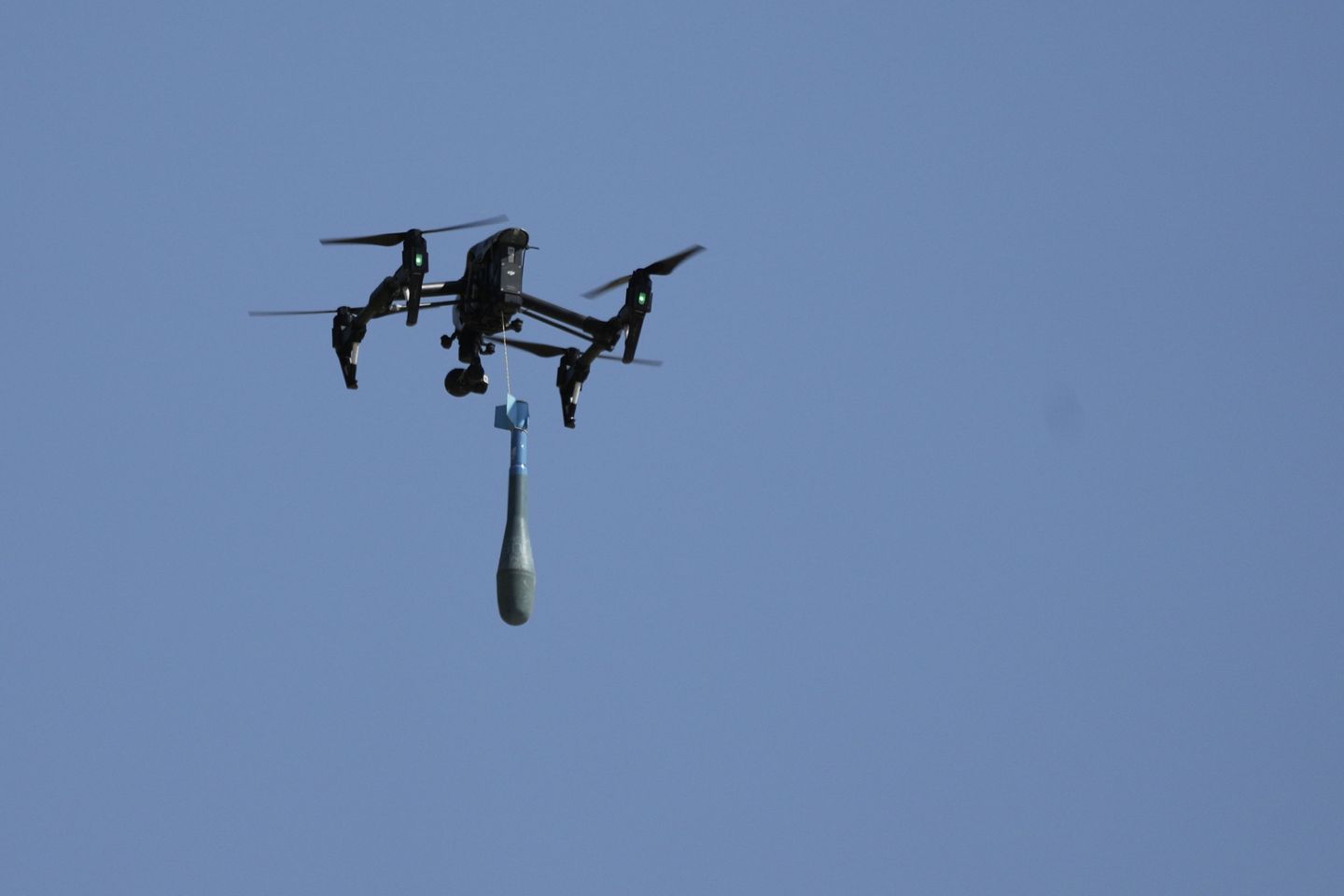
Drone warfare is emerging as a central strategic tool in the Trump administration’s plan to expand American military power.
The U.S. pioneered remotely piloted weapons during the war on terrorism in the post-9/11 era, when the term drone became a verb for effective strikes against al Qaeda figures in several corners of the world. The military term for missile attacks by large Predator and later Reaper unmanned aerial vehicles was simply “death from above.”
Since the early 2020s, drone weaponry has advanced dramatically from those initial, long-range missile carriers to an entirely new generation of warfare that has come into sharper focus during the Ukraine war.
In one recent two-day period, Russia fired 355 Iranian-made Shahed-type drones, including decoys, at Ukrainian targets. The wide-scale use of such one-way attack quadcopters and other pilotless aircraft has underscored how drone warfare is rapidly becoming the new face of modern warfare.
It’s not just Russia and Iran. Other U.S. adversaries are now in the drone manufacturing game, often pioneering inexpensive ways to mass produce basic but deadly small drones.
China has notably developed a vast slate of drones for both attack and support operations and is said to be producing as many as 100,000 small drones per month. By contrast, the U.S. defense industrial base is currently producing only about 5,000 to 6,000 small drones per month.
But under President Trump, the Pentagon is engaged in an increasingly aggressive push to accelerate the delivery of advanced, small and versatile drone systems to American warfighters across the services. And U.S. defense companies — new and the established primes — are scrambling in unprecedented ways to develop and scale the production of the transformative technology at a fraction of the cost of producing more conventional large drone platforms.
Drones today include unmanned aircraft, robot bomb-laden warships and underwater vehicles, and increasingly space weapon drones that are expected to be ready for use in any future conflict with China or other adversaries.
Swarms of hundreds of small drones are being developed by several companies for the mission of overwhelming air defenses, along with unmanned combat aircraft that will take to the skies together with manned fighter jets. Cargo drones also are planned for ferrying military supplies and ammunition to troops in the field.
There are even tiny drones the size of insects that U.S. officials say might be used by adversaries like China and Russia to deliver biological weapons to enemy forces in a conflict. Other drones are ready to conduct electronic warfare attacks and already are gathering intelligence and conducting reconnaissance — all made smarter with the increasing use of artificial intelligence.
Defense Secretary Pete Hegseth is fully on board. He announced a major drone initiative earlier this month, declaring that “drones are the biggest battlefield innovation in a generation” and signing a new directive that was dramatically delivered to him in front of a camera by a hovering quadcopter.
The directive orders all senior Pentagon and military leaders to adopt a new drone warfare strategy as a centerpiece of military innovation, noting that in Ukraine, most of the reported 400,000 to 700,000 casualties this year were caused by Russian drone strikes.
“Our adversaries collectively produce millions of cheap drones each year,” the defense secretary said in the order. “While global military drone production skyrocketed over the last three years, the previous administration deployed red tape. U.S. units are not outfitted with the lethal small drones the modern battlefield requires.”
The Pentagon is canceling restrictive drone policies put in place under the Biden administration, and billions have been requested by the Trump administration for drones in the fiscal 2026 budget. The Pentagon wants $13.6 billion for autonomous military systems, including $9.4 billion for unmanned and remotely piloted vehicles.
The request calls for autonomous land vehicles to get $210 million, while $1.7 billion is being sought for Army sea drones, including $7.34 million for autonomous underwater vehicles. Army reconnaissance drones would be funded with $1.1 billion, and software development for all military services’ drone programs could be funded with $1.2 billion.
The Navy wants $5.3 billion for its autonomous programs, an increase of $2.2 billion from last year — funding to procure three Boeing MQ-25 drone refueling tankers along with air, sea and underwater drones.
Transformative impact
Drone warfare captured the world’s attention recently in the daring raid inside Russia by Ukraine’s military that conducted a covert attack using truck-launched drones that struck some 40 strategic bombers parked on runway aprons at air bases.
Then Israel shocked militaries around the world with similar covert strikes against Iranian military commanders and nuclear scientists after setting up a secret drone base inside Iran.
To better battle enemy drones, like those used from trucks by Ukraine and the Israeli drone base inside Iran, the Pentagon has requested $3.1 billion for countering unmanned systems.
Military analysts see another front line in the emerging contest for drone warfare dominance: The Taiwan Strait, a 100-mile-wide waterway separating the self-ruled island democracy of Taiwan from communist-ruled mainland China, whose President Xi Jinping has made annexing the island a “core” Beijing interest.
Adm. Samuel J. Paparo, commander of the Pentagon’s Indo-Pacific Command, regards drone warfare as a central element in his strategy of deterring China.
“I want to turn the Taiwan Strait into an unmanned hellscape using a number of classified capabilities so I can make their lives utterly miserable for a month, which buys me the time for the rest of everything,” the four-star admiral said in June 2024.
He told The Washington Times in October that his “hellscape” drone concept grew out of the Pentagon’s program called Replicator, a Biden-era initiative that pushed drone designs to several defense contractors who were expected to rapidly produce large numbers at a low cost.
“The emphasis for Replicator is accessible, technologies applicable to the 21st century, like unmanned, autonomous vessels in this case, of, sea denial or air denial capabilities in tight, enclosed spaces that would be applicable to these geographies,” Adm. Paparo said, referring to the western Pacific.
Without providing details, he said Replicator’s drone systems are being delivered and tested. The hellscape program is said to have strengthened deterrence over just two years to a level that would have taken 10 years if the Pentagon’s traditional defense procurement system had been used.
Private sector scramble
Details of hellscape’s thousands of drone weapons remain closely held secrets.
However, the systems are reported to include the Switchblade 600, manufactured by Virginia-based AV, formerly known as AeroVironment; the Hero-120 suicide autonomous attack aircraft made by UVision, an Israeli company that produces drones in the U.S. through a partnership with the Virginia-based Science Applications International Corp. (SAIC); and the one-way attack unmanned surface vessel known as the Muskie M18, manufactured by Florida-based Maritime Tactical Systems (MARTAC).
The Navy’s high-altitude long-endurance unmanned aerial vehicle MQ-4C Triton maritime patrol drone, manufactured by Northrop Grumman, as well as other secret drone systems are also said to be part of hellscape.
Other companies are pushing advanced drones that could have a role, including California-based Anduril and Shield AI, the latter of which produces the V-BAT drone, which features so-called “Hivemind” technology that Shield AI boasts as the “world’s best AI pilot.”
Recent days also saw Florida-based L3Harris Technologies roll out a new slate of what it calls “multi-role vehicles that can easily integrate and launch from air, ground or maritime platforms.” The company launched “Red WolfTM” and “Green WolfTIM,” describing them as “flexible, modular and featur[ing] advanced software for in-flight collaboration and re-targeting,” while also being able to “support swarming capability of autonomous aircraft.”
It remains to be seen whether those products will be featured within hellscape.
The Air Force already has large numbers of MQ-9 Reaper drones, manufactured by General Atomics, and has conducted simulated strikes against Chinese targets on disputed islands in the South China Sea.
In April, Marine Lt. Gen. Benjamin T. Watson, head of Marine Corps Training and Education Command, said drones and small guided munitions will be used in the future like rifles.
One Marine initiative is called the Marine Corps Attack Drone Team that uses “first-person-view drones.”
Gen. Watson said the service is working on how to “bring these in, at scale, and we turn a rifleman into somebody who cannot just kill an adversary with a precision weapon at 500 meters but can do it out at 15 to 20 kilometers.”
The Army is also fielding new tactical drone systems for troops.
“Combat is moving into a very drone-heavy type of warfare,” said 1st Lt. Alexis Gavrillis, a military intelligence officer with the Army’s 317th Brigade Engineer Battalion at a base in Romania. “With reconnaissance, fires, and other capabilities, these are going to help the Army get one step closer to modernizing the way we fight.”
Army units employed MQ-1 Predator drones — also a General Atomics platform — during the wars in Afghanistan and Iraq.
Today, the service is using short- and medium-range reconnaissance drones, including the Skydio system, manufactured by California-based Skydio, that can fly for 30 minutes at a range of 1.8 to 3.7 miles.
Across the services
Another medium-range Army system is called Ghost-X, produced by Anduril, with a range of between nine and 15 miles and an hourlong flight time.
Benjamin Jensen, a senior fellow with the Center for Strategic and International Studies, said the military services are exploring several types of drone systems and loitering munitions.
Army drones include quadcopters that can drop bombs and sensors on unmanned ground vehicles at small unit levels. “The focus is on enabling frontline innovation and tactical creativity,” Mr. Jensen said.
The Navy is working with the Defense Advanced Research Projects Agency on unmanned surface vessels in a program called No Manning Required Ship.
“These semi-autonomous platforms are part of a broader strategy for distributed maritime operations, allowing the fleet to project power, conduct [intelligence, surveillance and reconnaissance], and launch strikes with reduced operational risk,” Mr. Jensen said. “By operating independently or in coordinated swarms, these vessels support both conventional missions and unconventional naval warfare in contested environments.”
The Air Force drone program includes the Collaborative Combat Aircraft, which is being developed by Anduril, Boeing, General Atomics, Lockheed Martin and Northrop Grumman, and features human-machine systems that fly with crewed aircraft. The drones are expected to be able to conduct electronic warfare, attack enemy air defenses and carry out deep-strike missions.
The Marines are using drones for coastal operations in ways that will enhance maneuver warfare, said Mr. Jensen. “These capabilities are particularly useful in island chains and coastal terrain, where dispersed formations must scout, strike, and deceive in fluid environments,” he said.
Not everyone in the national security community supports the new drone-oriented military strategy.
Retired Navy Capt. Jim Fanell, a Chinese expert and former intelligence director for the Pacific Fleet, said the Navy, in particular, must focus on building more ships to strengthen naval power and reach in confronting China.
Drone weapons, both aerial and surface, lack the range of manned ships and aircraft in the vast expanses of the Pacific Ocean that would involve a conflict with China.
Mr. Fanell said the Pentagon needs to set clear priorities on spending and weapons procurement that must include a major buildup of warships and submarines.
“Those who promote drones are misled and mistaken,” he said. “America cannot defeat the PLA navy with only drones, which is what many in D.C. are pushing.”
Adm. Paparo, the Indo-Pacific commander, also has said drones alone will not be enough to confront the threat from China. He has said that U.S. forces will be required to maintain both air and maritime superiority with traditional manned systems.
• Guy Taylor contributed to this report. He can be reached at gtaylor@washingtontimes.com.










